Haggs Brow Cave Excavations, Lower Winskill
Yorkshire Dales National Park. May 2016.
A personal account by Vince Simmonds.
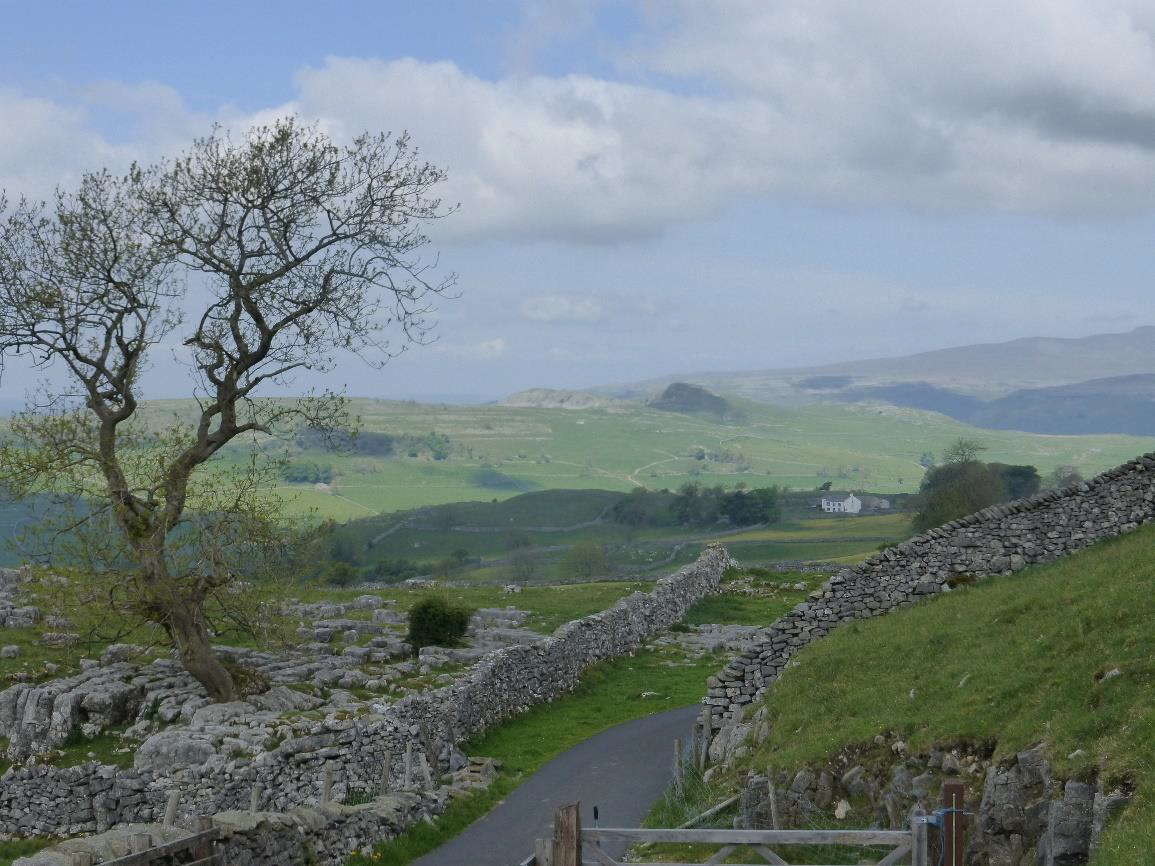
Looking down the track to Lower Winskill.
Introduction:
Haggs Brow Cave is located on the Haggs, an area of former managed
woodland or wood pasture at Lower Winskill Farm, near Settle. Haggs Brow Cave is a relict
stream cave with clastic sediments filling the interior almost to roof. The interior is
inaccessible and has yet to be explored. The mouth of the cave is blocked by turf covered
boulders. The boulders may derive from the collapse of the cave roof and walls when the
cave formerly extended further out than today, or they may derive from intentional blocking
of the entrance by people at some time in the past. The intentional blocking of cave entrances
has been suggested for some sites in the Dales, but an example has yet to be fully recorded
and dated. Haggs Brow Cave lies within the medieval infield area of the upland livestock
farm at Winskill, belonging to the Cistercian monastery of Sallay Abbey, near Clitheroe. The
excavations aim to recover environmental evidence such as snail shells and the bones and
teeth of small vertebrates, to help understand changes in vegetation and land use in the
medieval period. All sediment will be wet sieved on site using apparatus specially built for
scientific cave work by John Howard of the British Cave Research Association’s Cave
Archaeology Group (Lord, 2016).
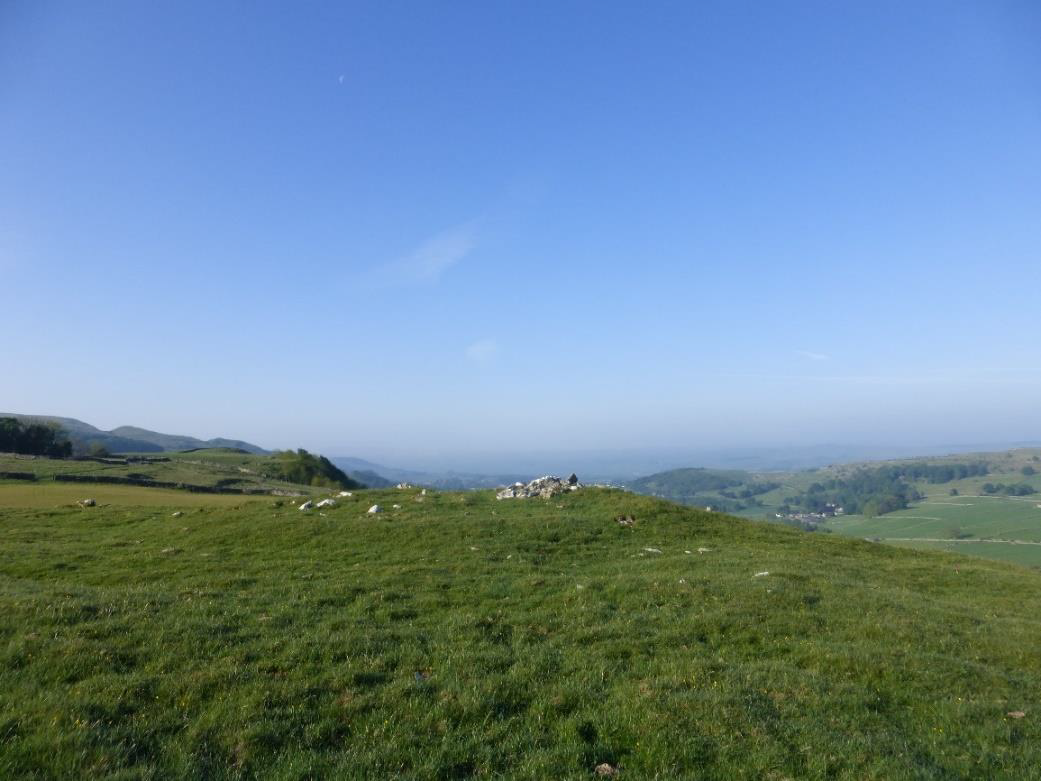
This cairn is evidence for prehistoric human presence in this landscape.
Tuesday 24th May: An early morning stroll with my wife and the dog over to Harptree combe, across fields and to the site of the c.12th C Richmont Castle. Then spent some time messing around getting kit together and the van loaded ready for the journey north to Lower Winskill.
Got underway at 11:00am, stopping for fuel in Bristol and then on to Avonmouth to join the motorway. A mostly uneventful journey north a brief stop at Keele for a toilet break. Took the M65 at Preston, ending up at Skipton following the A65 towards Settle. I stopped in Settle for some supplies and then made my way up to Lower Winskill where I met Tom Lord, et al. where they had spent the day at Haggs Brow. After enjoying a cup of tea Tom took me over to the dig site for a look and a chat, then headed back to the farm where I was shown where to pitch the tent and the facilities available.

A panoramic view from the camp site.
After pitching the tent, I went down to Settle for fish and chips followed by a couple of pints in the Talbot Arms before returning to the farm to retire for the night.
The journey length about 250 miles and it had been a fine sunny and warm day.
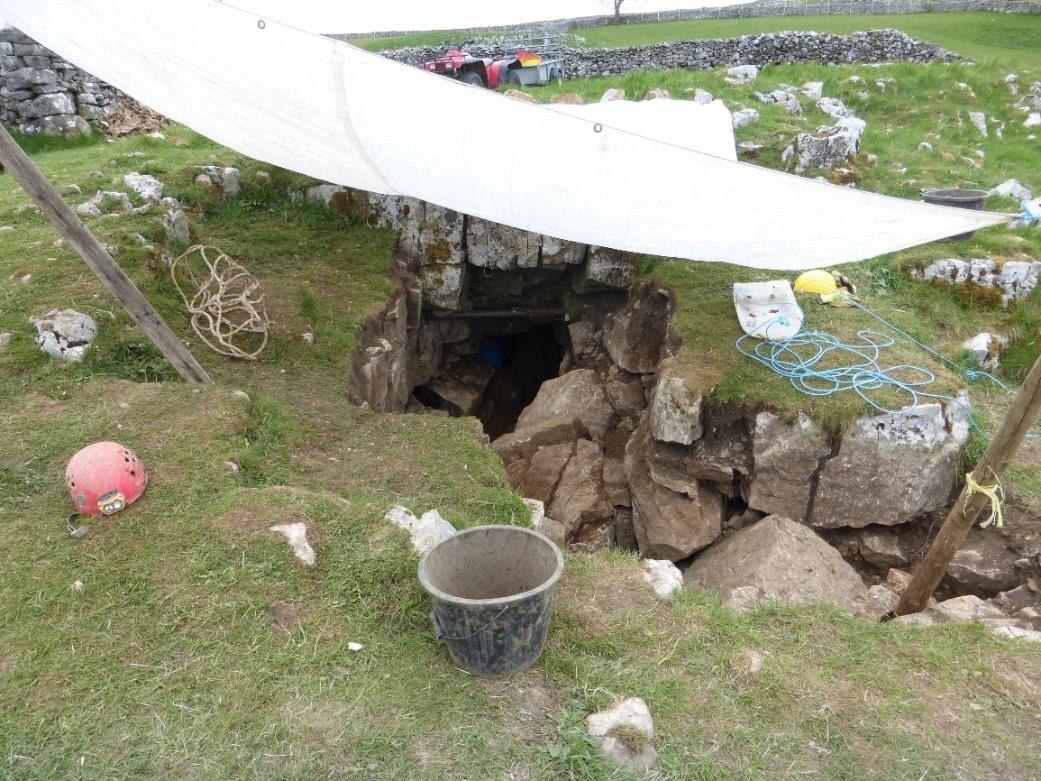
The entrance to Haggs Brow Cave.
Wednesday 25th May: After an okay night in the tent and a leisurely breakfast I made my way around to the farm to meet up with the some of the other participants involved in the project – unfortunately don’t know everyone’s names yet, but there was John ‘Lugger’ Thorp, Wendy Thorp, Tom Lord, John Howard, et al. More tea, some milling around before things started to happen.
Lugger led the way into the cave, I followed, rocks started to be passed back to those behind. Forward progress was made, blocks that restricted access were drilled and capped and the debris moved back. The cave passage beyond the entrance splits either side of some narrow block breakdown. We initially went to the right (although there was also a restricted route to the left) and then through a window to the regain the left passage where a way ahead was visible. More capping of rocks allowed access to c.15 metres of low gnarly, rock strewn passage (total present cave length c.20 metres), the passage is c.3.5m at the widest point and about 0.70 metres high at maximum.
We did recover the remnant of an old rabbit snare and the bones of some long dead baby rabbits but, unfortunately no archaeology or palaeontology of significance. I think that if anything is to be found it will probably be at a lower depth in the sediments well below the rock scatter. Assisted Lugger in surveying the cave while John Howard started to make a photographic record before the camera died. That was just about it for the day and we made our way out of the cave. On the surface it had been raining. Got changed and a group of us headed down to the Fisherman’s in Settle for a fish and chip supper. Afterwards Tom and I went to the Talbot Arms for a couple of their finest glasses of ale before heading back to Lower Winskill. It was still raining.
Thursday 26th May: There was a good deal of rain last night and I realised the tent was leaking a bit when my feet felt a little cold and damp, at least the forecast is better for the next few days.
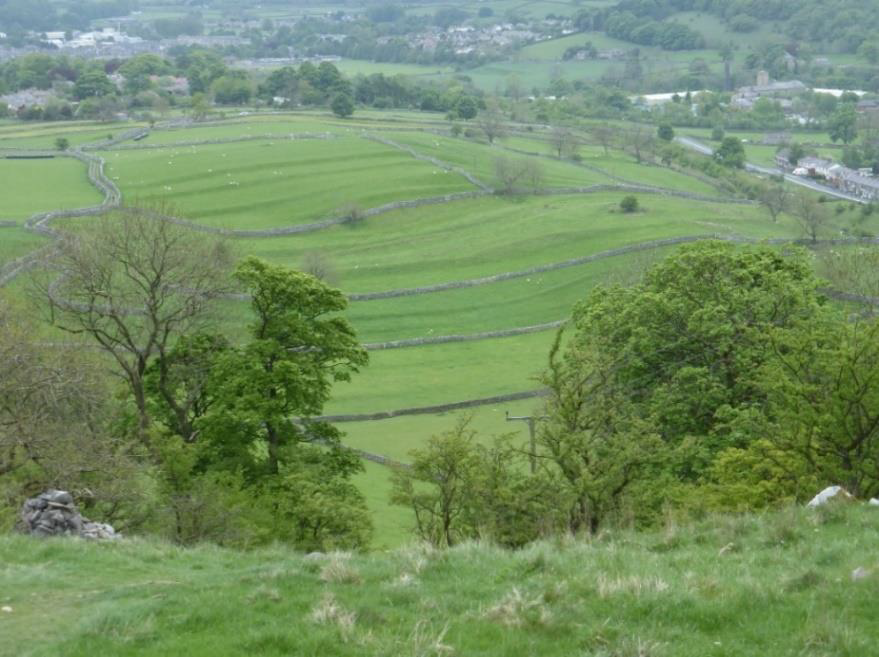
The view from Haggs Brow, looking down the Ribble valley. The valley has a patchwork of
ancient field systems with strip lynchets, earthworks and farmsteads.
My first task of the day was to go underground and photograph some skeletal remains (small baby rabbit) at the present end of the cave. After the photographs were done then sampling of the sediment bank beyond the skeletal remains was possible. From a small test pit c.0.3m2 4no. bags were filled with sediment that comprised pale grey-brown silty fine sand with fine gravel. Bog (AJ) gave assistance in getting the bags out to the surface and onto be wet sieved.

Skeletal remains of rabbit in Haggs Brow Cave.
Up to now the main focus of activity has been in an easterly direction, the work changed to concentrate on a lead to the west of the cave entrance. This required a good deal of capping to remove some obstinate boulders and allow better access. Several more sediment samples were taken from differing layers. More capping of boulders followed, there is some open space ahead although not particularly big space. When the capping was done and debris cleared I went in for a gander and the way ahead did not appear to be all that obvious, there was still more work needed to gain better access, the squeeze through was not workable. Lugger then went in for a look and started hammering again and came back with the opinion that some more work was needed, which concurred with the opinion that I had ventured.
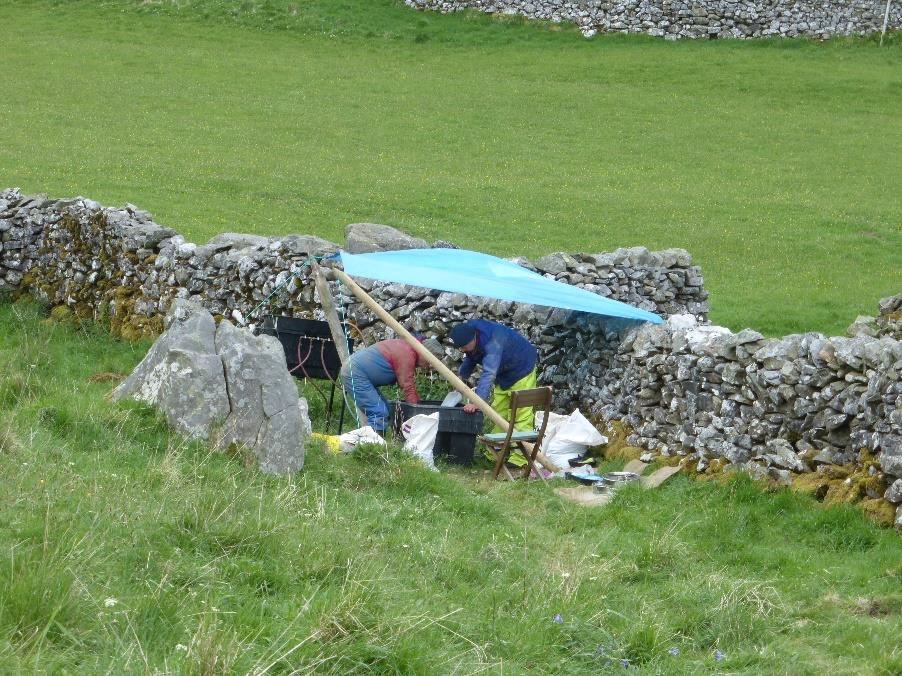
Wet sieving underway at Haggs Brow.
It had been my intention to go over to take a look at Victoria Cave but low cloud dampened my enthusiasm, so I went for a stroll around Settle instead, where there is some decent architecture to be seen. Pie and chips for supper followed by beer in the Talbot Arms.
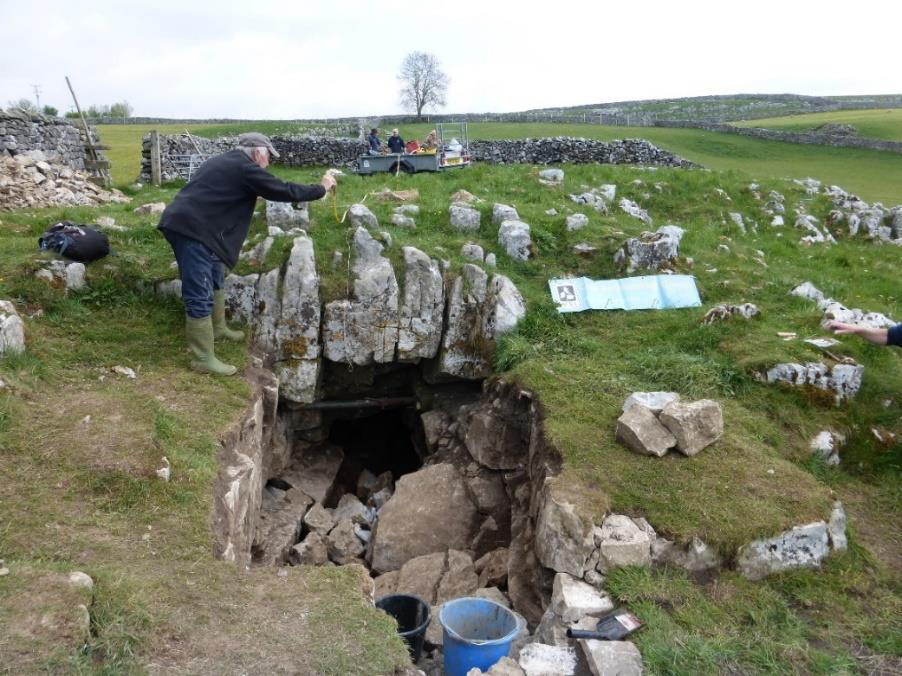
The entrance to Haggs Brow Cave looking east, the west passage is to the left of the buckets.
Friday 27th May: Woke up to a pleasant morning. On inspection at the bottom of the tent discovered that there was rather more water than I had realised so I spent some time mopping out and getting things aired and dried. After that breakfast and write up the diary.
At Haggs Brow Cave the first job of the day was to clear more rock from the west passage, when Tony Brocklebank turned up he went ahead and capped more rock. When TB came out for a fag break I went back in to clear the fractured rock along with a whole lot of cobbles and boulders allowing access to a better view of what lay ahead – much as I had thought, a lot of rock and no clear or obvious way on. Lugger appeared at lunchtime and a debate ensued, I headed off to Haggs Cave located lower down the hillside with John Southworth. A short drop down a plastic pipe, through a low mucky grovel into more spacious passage with plenty of calcited boulders and a liberal coating of grey-brown silty fine sand with fine gravel, very similar to the sediments noted in Haggs Brow Cave. The downward leading passage gets to a low, wet and mucky flat out crawl, too snug for JS and too mucky for me in just lightweight cotton overalls. The upward continuation of the passage leads through a constricted window to a [terminal] chamber with calcited boulders, interestingly the rockfall mirrors the roof profile above. An exit was made although the plastic pipe provided a little entertainment now we were both muddy and damp.
Back at Haggs Brow no further digging was taking place and preparation was underway to pipe the entrance ready for backfilling, this was now a job for tomorrow.
In the evening Tom arranged a BBQ with Terry O’Connor and Peter Wilson who were staying at the farm. It was a fine evening although a little chilled as the sun set. Tom took us for a guided walk across the fields to look at the prehistoric cairn, pointing out several examples of land usage, and some medieval boundary walls. There was an appreciation of the local flora, in particular those species that might be indicators of a past wooded landscape, such as bluebells, geraniums and meadowsweet.
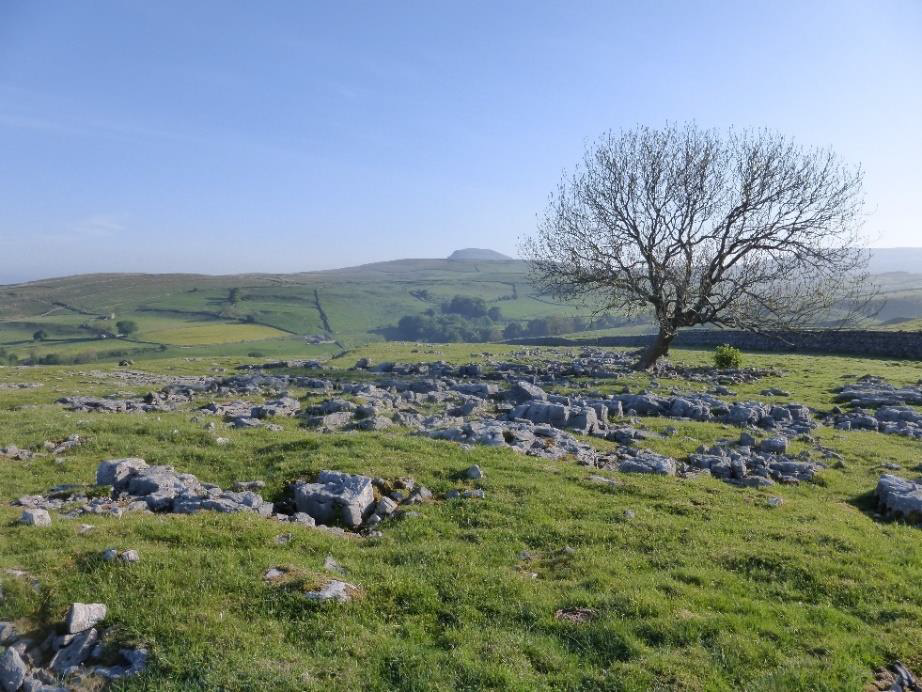
Limestone pavement has been removed as ‘rockery’ stone in the past, it was mainly the loose
stone that was taken, the more solid rock left alone. Penyghent can be seen on the horizon.
Saturday 28th May: It was another very pleasant morning to awake up to and I enjoyed a leisurely breakfast, then settled back for a while to write up diary and to read a little.
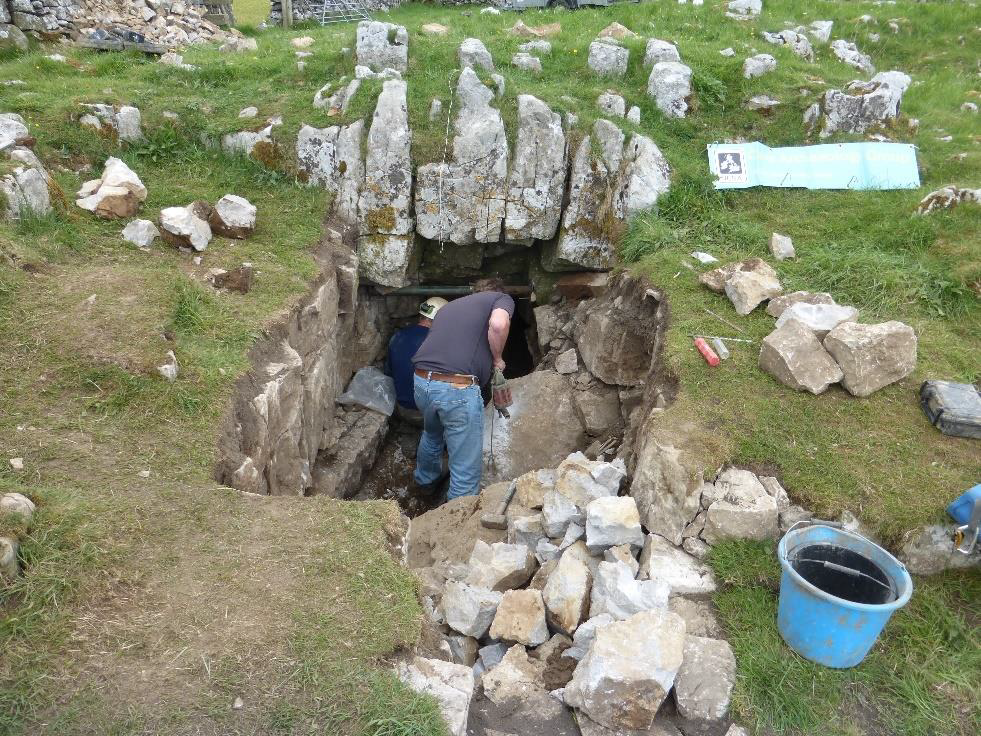
Tony and Lugger applying some rock engineering to allow insertion of the entrance pipe.
The day was spent installing the piped entrance to Haggs Brow Cave. This needed some more rock removal, further clearance of debris and some fiddling about to get it into the best fit. Then drystone walling at both ends of the pipe and backfilling to hold it securely in place, the final act was to replace the grass turf. Access to both the east and west passages is still possible although a grid was placed over the opening because of the close proximity to a well-used footpath.
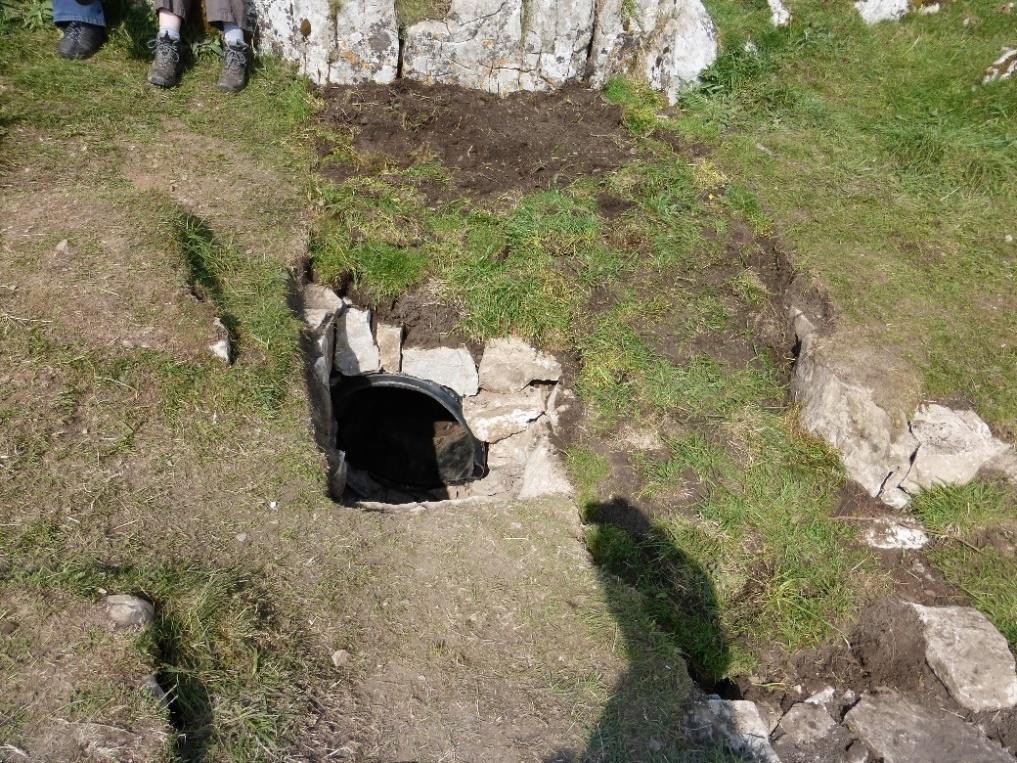
The finished entrance to Haggs Brow Cave.
The weather had been good all day and I finally got my act together to walk along Langcliffe Scar and to visit some of the caves found there.
First stop along the scar was at Jubilee Cave.
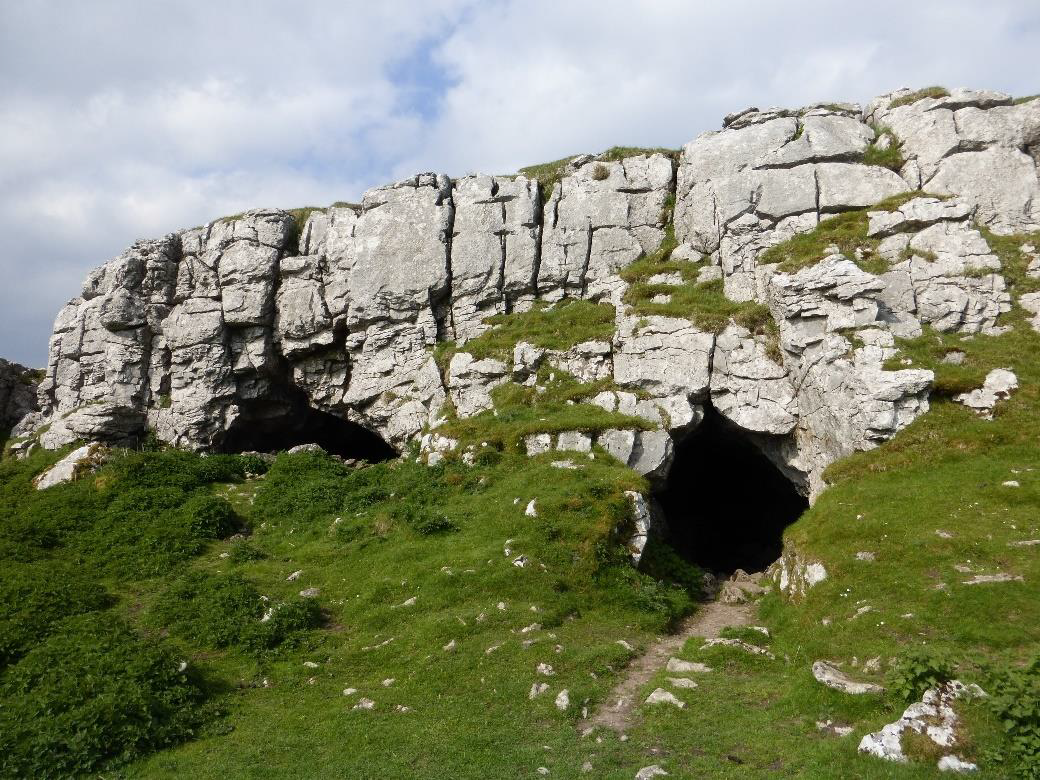
Jubilee Cave
The cave has several entrances, passages much used by sheep and there is an aroma in the warm evening sunshine. The cobble strewn passages have the evidence of being well visited by tourists as well. Excavated by the Pigyard Club who found Neolithic and Celtic remains.
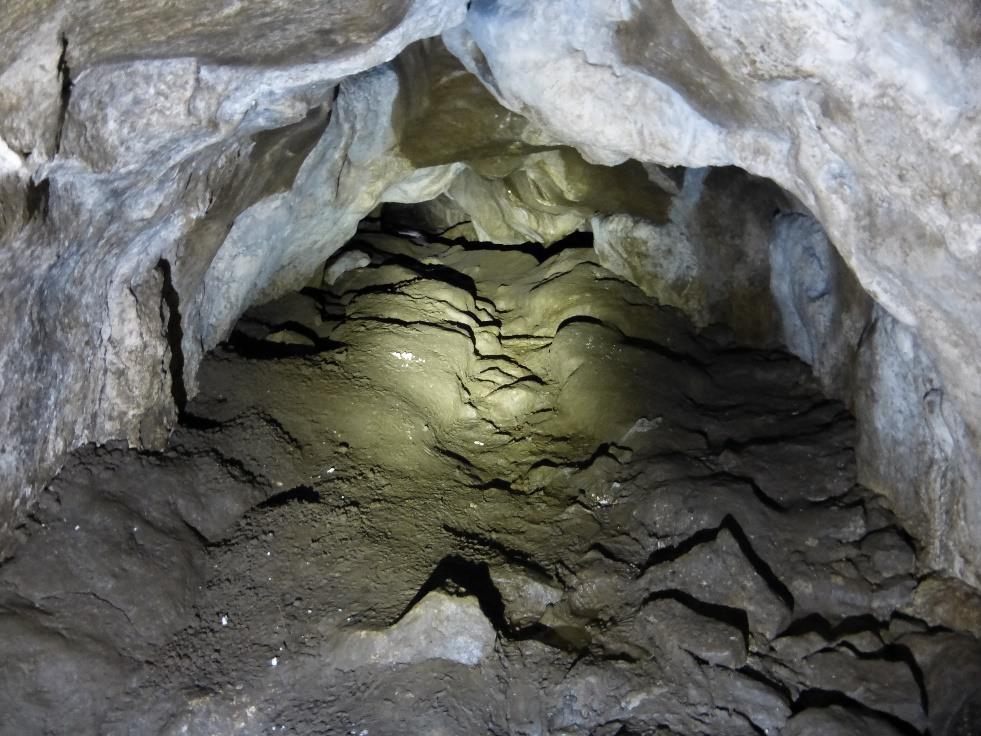
Inside Jubilee Cave.
Next stop was Wet Cave. This cave consists of a single, mostly walking sized passage, c.25-30m in length ending in a flowstone blockage. Located on the path up to Victoria Cave.
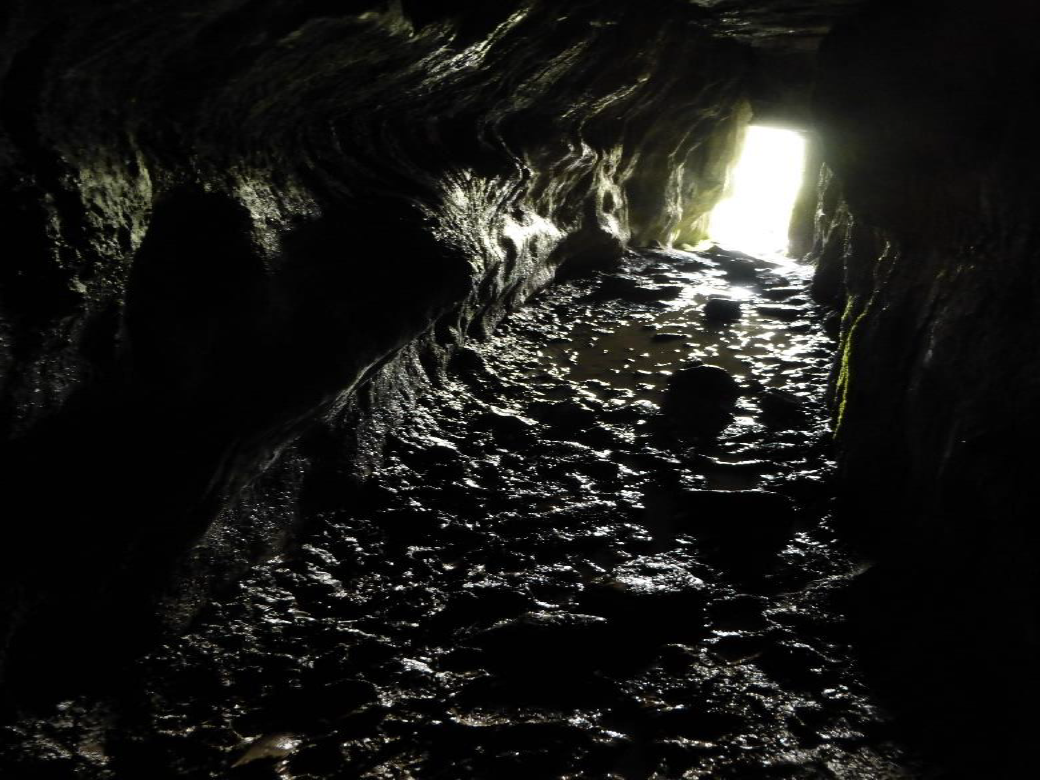
Looking out from Wet Cave.
Victoria Cave. I was surprised by the size of the entrance and by the spoil heap outside, hundreds of tons of sediment have been excavated from the cave.
The interpretation of the sequences revealed by the excavations at the site show that during the Upper Pleistocene Interglacial c. 130 000 – 120 000 yrs ago the cave is used as a den by spotted hyenas and bones including hippopotamus and rhinoceros were dragged into the cave. 120 000 – 10 000 yrs ago comes the Upper Pleistocene Last Glacial when the cave becomes filled with layers of clay as the glaciers melt and refreeze cyclically. Around 12 000 yrs ago the Palaeolithic Post Glacial, the glaciers retreat leaving a thick clay deposit. At this time brown bears take up residence and the first humans arrive. The next major phase of human cave usage is 2nd – 4th C AD when the cave is suggested to have been used for worship, storage and shelter for craft work. From then until the 19th C small mammals take up residence. The main period of excavation is between 1867 – 78 although there has been further work to this in later years. The description above is largely based on the information board located at the entrance to the cave.
Inside the cave there is plenty of mess created by the numerous jackdaws that have taken up residence, and from sheep and, the usual crap left by human visitors too idle to take it away with them.

The entrance to Victoria Cave.
I came across an area with some inscriptions dated 1837 which is the date given for the rediscovery of the cave. There is more recent graffiti as well, some overlying the older inscriptions. Later, I discussed the inscriptions with Tom who thinks they are probably genuine.

Inscription ‘R Snell 1837’ found in Victoria Cave
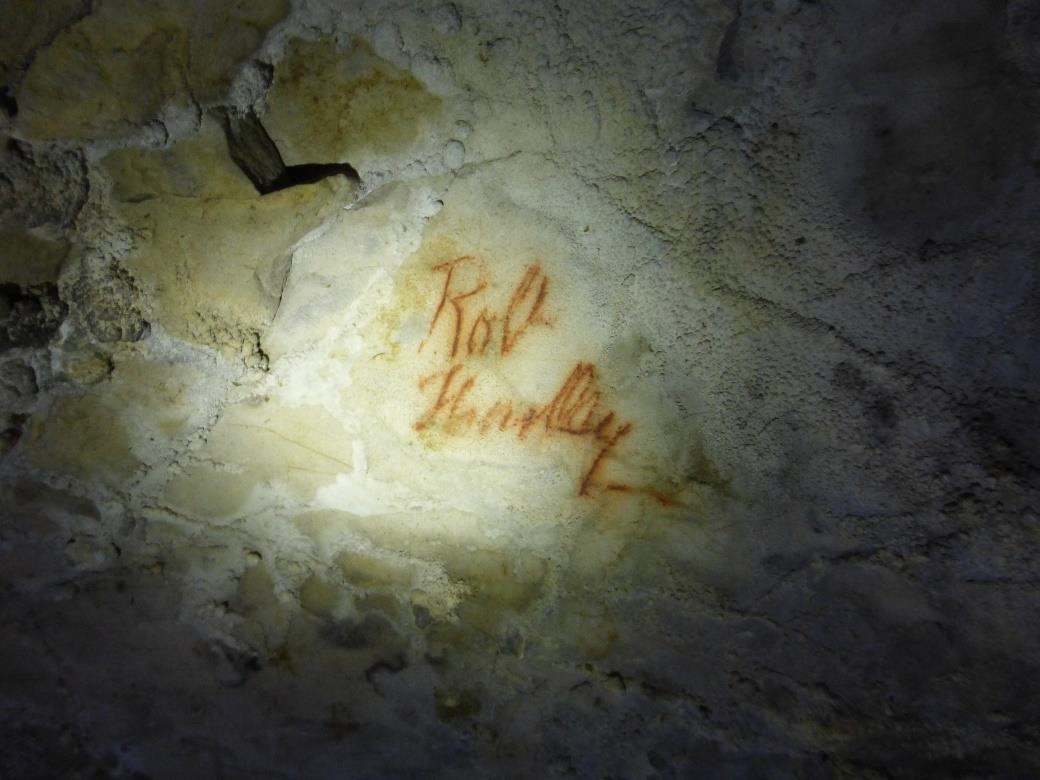
This inscription was written on the cave ceiling suggesting it was placed there before the
sediment had been removed.
Just along the scar from Victoria Cave is found Blackpot.
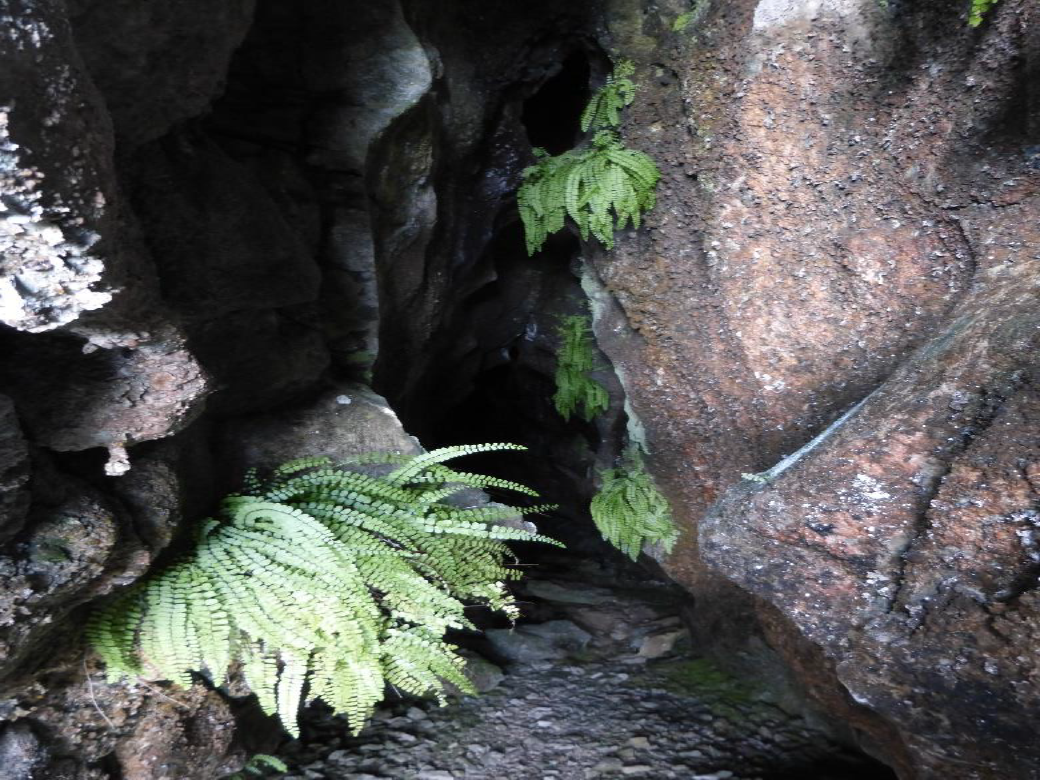
Blackpot Cave
Blackpot Cave consists of a descending rift c.15m in length becoming too narrow there is a short pitch at the end that I didn’t bother to descend. There were some fine ferns growing on the sidewalls.

There were some fine early purple orchids in Langcliffe Scar.
Gaining access into Albert Cave requires a climb around the gate through the gap on the left side. The spacious entrance chamber becomes lower as the floor rises and the roof is encrusted with some ancient calcite. There is also a liberal coating of silt and sand, muddy in places.
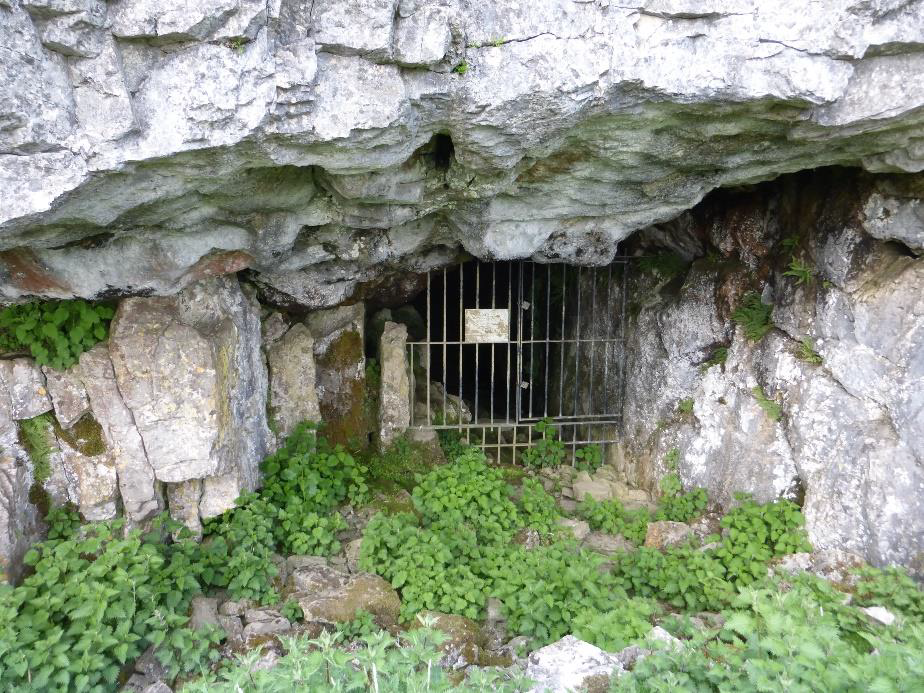
The gated entrance to Albert Cave.
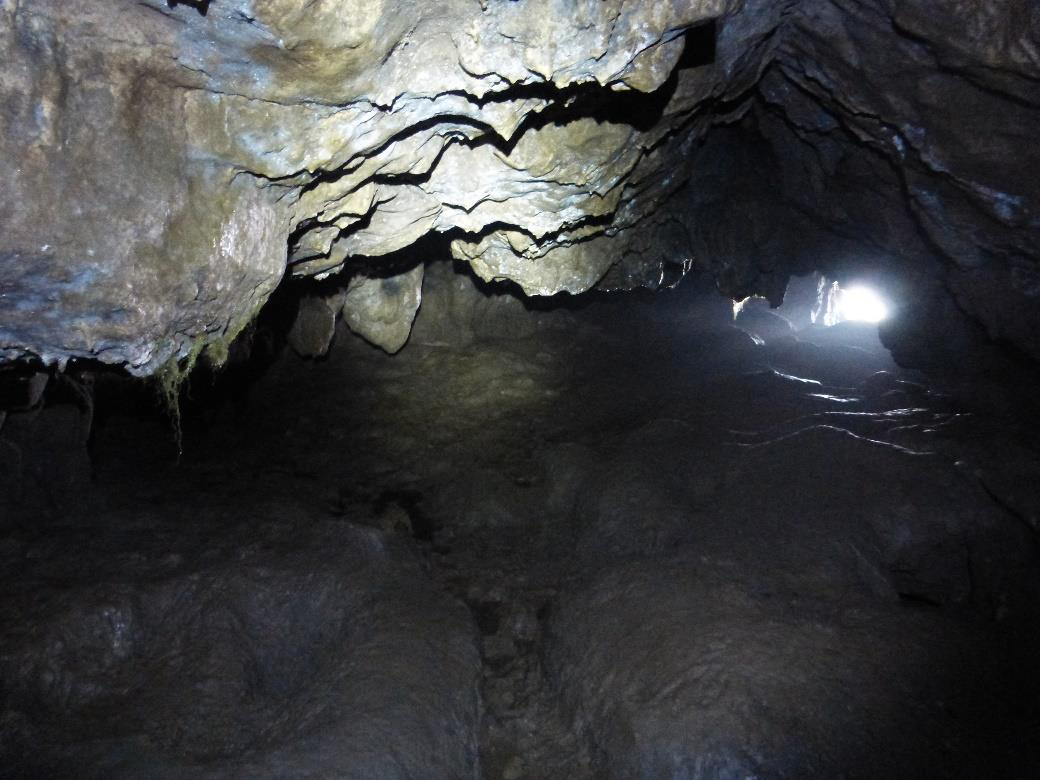
Calcite formations within Albert Cave.
Sunday 29th May: All the digging, etc. has been done at Haggs Brow so the plan is to travel back to Mendip sometime today.
It was another glorious morning so I decided to have a walk before breakfast. Headed over the fields to the prehistoric cairn we had visited on Friday evening to take some photographs. The views of the Ribble valley from here are stunning and there is a real feeling of space as you look towards the mountains in the distance.
On the way back I met Tom and together we walked around the farm land where he pointed out a number of interesting features. Tom showed me some interesting drystone walls that he suggests date to c.12th-13th C based on the construction style used. There are similarities with stone wall typology found in France and are likely to have been introduced to Britain after the 11th C Norman invasion.
After breakfast in the farmhouse with Tom it was time to pack the tent away into the van along with the other paraphernalia. Said my farewells and set off for Mendip in still glorious sunshine at around 10:30am, 250 miles or so later arrived back at Rugmoor, it was just about 15:30pm although I did stop briefly in Bristol. The journey back had been mostly stress free, but there were plenty of roadworks along the way.
I had a thoroughly good time in the Dales and had met a group of fine like-minded individuals coming together in order to complete an interesting project. Hopefully this is the first phase of a continuing investigation of a number of other features noted at Lower Winskill and I can make a return later in year.
Thanks to all for making me feel very welcome.
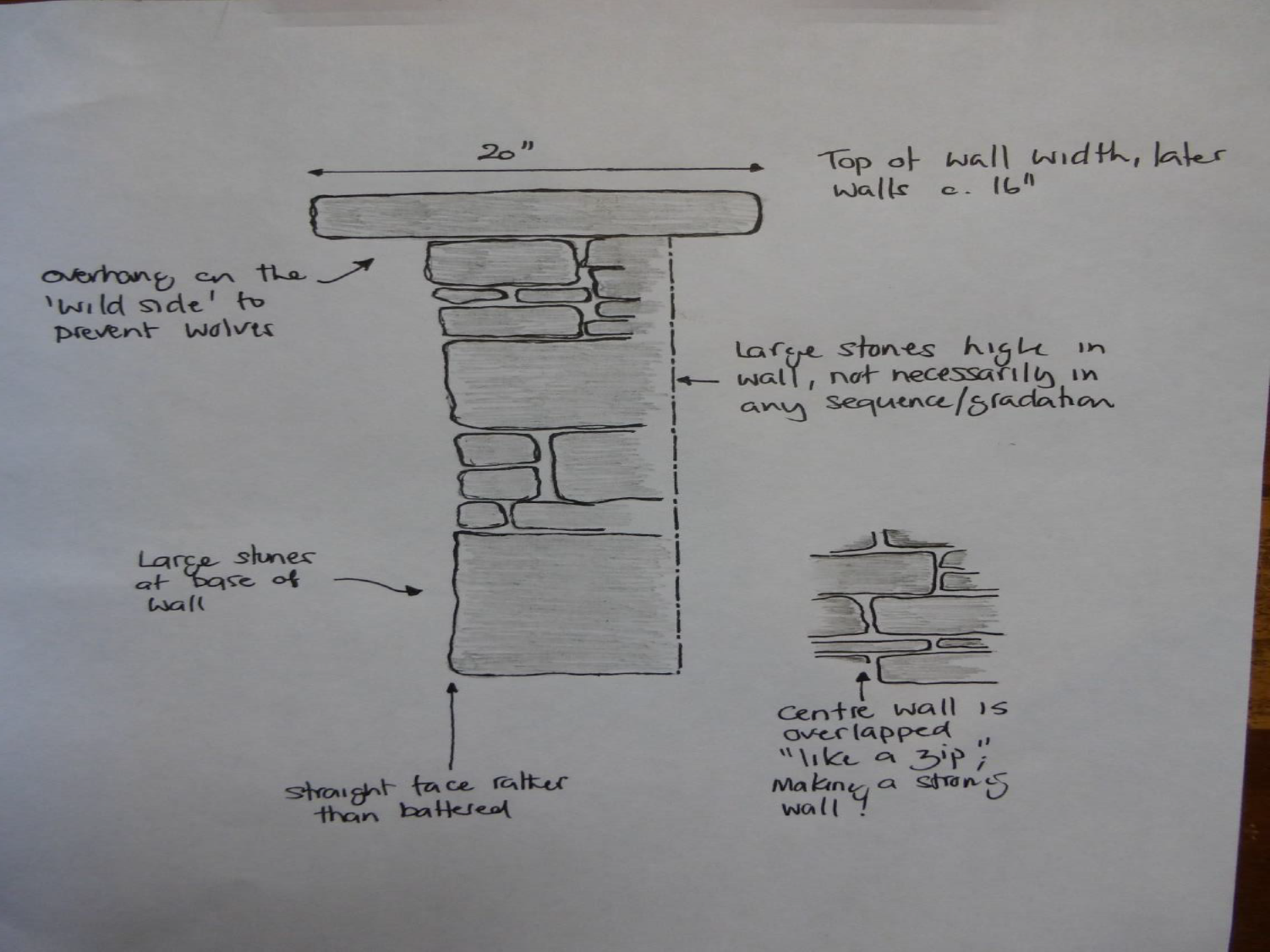
A schematic diagram highlighting some of the features of medieval drystone walls observed at Lower Winskill Farm
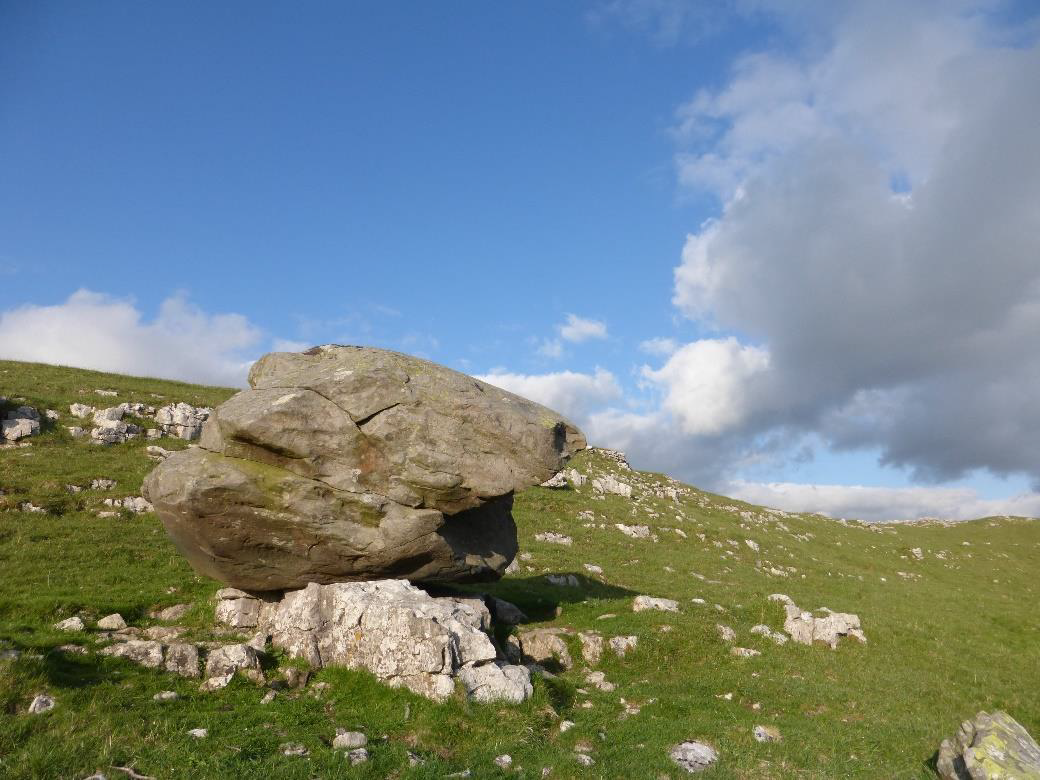
Erratic, Lower Winskill.
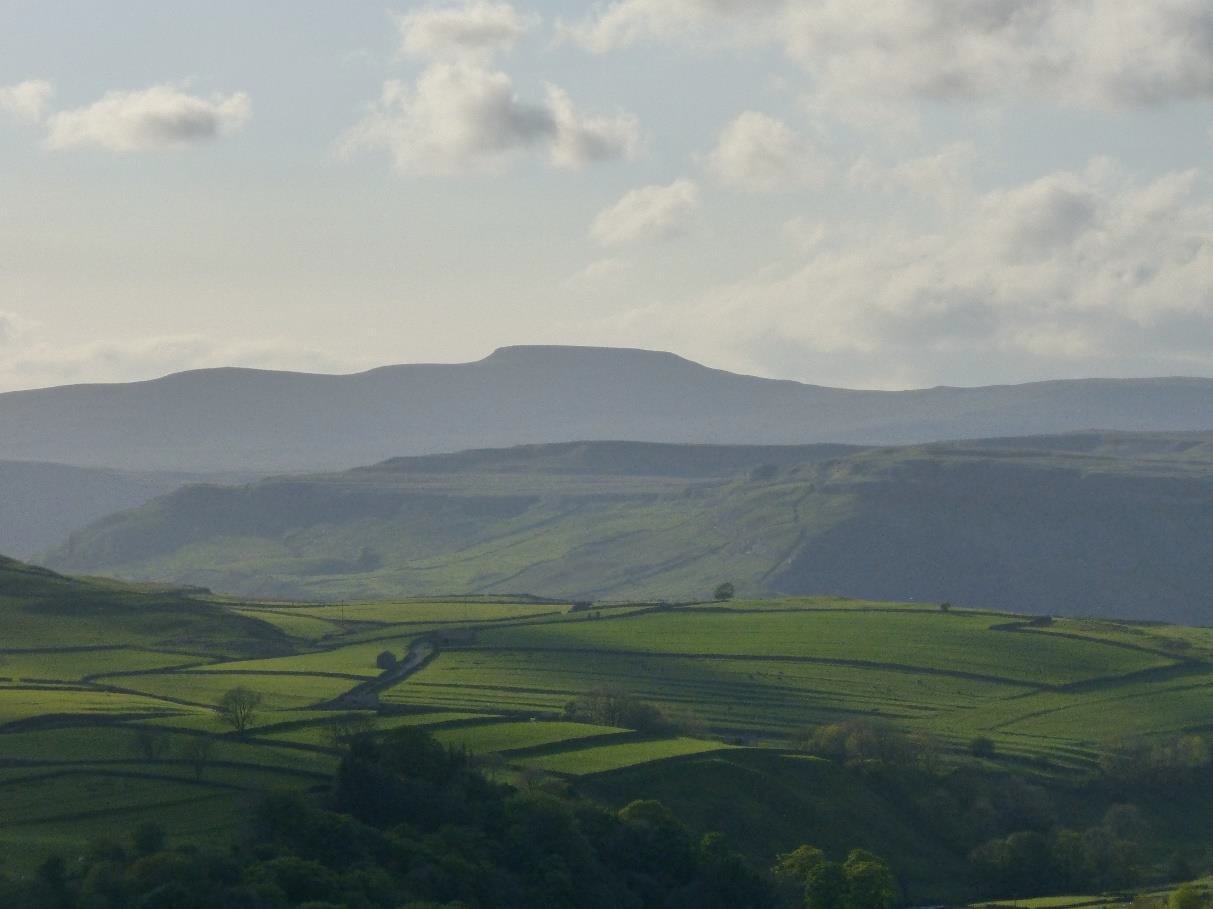
Ingleborough from Lower Winskill.
